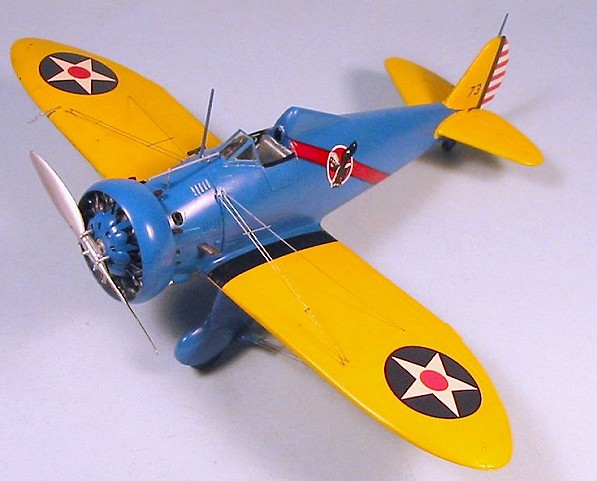
| KIT #: | ? |
| PRICE: | $? |
| DECALS: | Two options |
| REVIEWER: | Tom Cleaver |
| NOTES: | 20th Pursuit Group boxing |

| HISTORY |
Billed for publicity purposes as the “revolutionary Boeing fighter,” the Boeing P-26A was a mixture of old and new. The first all-metal monoplane fighter to serve with the Air Corps, it was also the last USAAC fighter with externally-braced wings, an open cockpit, and fixed undercarriage. It was also the last Boeing-designed fighter, bringing to an end the company’s 15 year domination of the fighter market for both the Army and Navy.
Faced with a new generation of monoplane bombers that were faster than its biplane fighters in the early 1930s, the USAAC approached Boeing with a requirement for a monoplane fighter that would be faster than any bombers flying at the time. Boeing began the work privately that month, with the project designated Model 248. On December 5, 1931, Boeing and the Air Corps signed a bailment contract for three prototypes, designated XP-936. The X-series of "project numbers" were allocated at Wright Field during 1930-34 to aircraft built by private companies without government funding but with Army-owned engines and other equipment on loan.
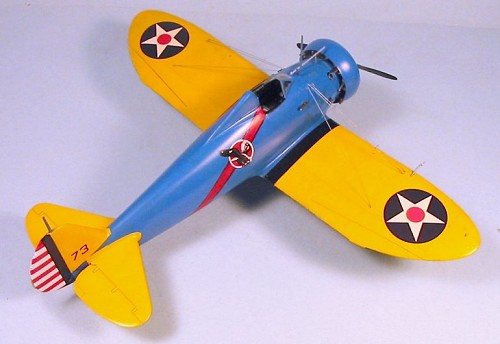 Construction of
the Model 248 began in January 1932. The design was a compromise between
the advanced ideas of Boeing and the conservative, cautious approach
favored by the USAAC. The Model 248 (XP-936) was an all-metal low-wing
monoplane with wire-braced wings of low aspect ratio with a thin section -
a cantilever wing was rejected as not being strong enough for a fighter.
The use of external wire bracing for the wing might seem at first sight to
have been a retrograde step, however such bracing allowed a lighter wing
structure. The horizontal tailplane was fully cantilever construction.
Construction of
the Model 248 began in January 1932. The design was a compromise between
the advanced ideas of Boeing and the conservative, cautious approach
favored by the USAAC. The Model 248 (XP-936) was an all-metal low-wing
monoplane with wire-braced wings of low aspect ratio with a thin section -
a cantilever wing was rejected as not being strong enough for a fighter.
The use of external wire bracing for the wing might seem at first sight to
have been a retrograde step, however such bracing allowed a lighter wing
structure. The horizontal tailplane was fully cantilever construction.
The fixed undercarriage did add extra drag, but it had an advantage in reducing weight and structural complexity and provided a structurally-efficient low anchor point for the flying wires. The rear portion of each undercarriage unit consisted of an inverted tubular bipod fastened to the front and rear wing spars. The flying wires were attached to the apex, and the wheel pivoted about the apex on an arm, with the landing loads being absorbed through a shock absorber strut connecting the wheel axle to the front spar.
The gear being separately sprung could allow the airplane to start rolling from side to side when taxying over uneven ground, and the P-26A acquired the nickname “limber legs” in service. Pilots soon learned not to advance the throttle too quickly on takeoff, as the increased torque could compress the left main gear to the point that the left horizontal stabilizer touched the ground, which could result in a ground loop on takeoff.
The fuselage was of a semi-monocoque type with aluminum bulkheads and the powerplant was the proven Pratt and Whitney R-1340-9 nine-cylinder air-cooled radial. A Townend drag ring was fitted around the engine and armament was either one 0.50 caliber M2 and one 0.30 caliber M1 machine guns, or two 0.30 caliber M1 machine guns, mounted in the sides on the cockpit floor and firing through the engine cylinder banks.
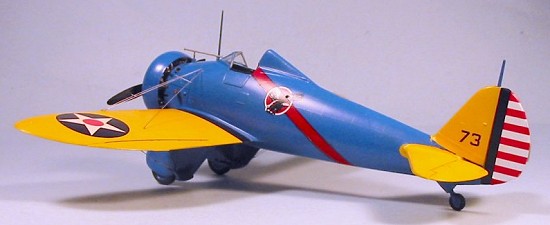 Demonstrating how
different aircraft development was 70 years ago, the P-26 project
progressed from drawing board to first flight in only 9 weeks, when the
first XP-936 was flown on March 20, 1932, by test pilot Les Tower.
Manufacturer’s trials progressed so quickly that only 35 days later the
prototype was sent to Wright Field for Army evaluation on April 25.
Demonstrating how
different aircraft development was 70 years ago, the P-26 project
progressed from drawing board to first flight in only 9 weeks, when the
first XP-936 was flown on March 20, 1932, by test pilot Les Tower.
Manufacturer’s trials progressed so quickly that only 35 days later the
prototype was sent to Wright Field for Army evaluation on April 25.
Comparing the performance of the XP-936 with the P-12F biplane, which was still in production when the XP-936 was delivered, the XP-936 had a later version of the same engine used by the P-12F, which gave the XP-936 only a 20 hp advantage over the P-12F, and was also 39 lbs heavier than the P-12F. Proving the superiority of the monoplane, it was 27 mph faster and outclimbed the P-12F by 476 ft/min. Though the XP-936 outperformed many contemporary Air Corps warplanes, it was slower than the expected performance of the Martin B-10.
The three XP-936s were assigned the designation XP-26 when purchased by the Air Corps, then changed to the service test designation Y1P-26, and finally to plain P-26. On January 11, 1933, 111 aircraft were ordered under the designation P-26A, with the order soon increased to 136; the additional planes were completed as the P-26B and P-26C. This was the largest order for a single aircraft type since the Boeing MB-3A of 1921.
The first P-26A flew on January 10, 1934, with the last aircraft of the initial order for 111 aircraft delivered on June 30. The unit price per plane (less engine and government- furnished equipment) was $9999, compared with $10,197 for the P-12E biplane it replaced, making this the only times when a new military aircraft was cheaper than the one it replaced.
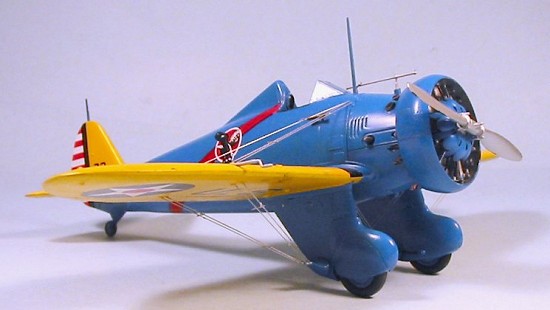 On February 22,
1934, Lt. Frederick I. Patrick of the 20th Pursuit Group made a forced
landing during a routine flight. The aircraft flipped over on its back,
inflicting only minimum damage to the aircraft while Lt. Patrick died from
a broken neck. As a result, the headrest height was increased by eight
inches, which delayed further deliveries until this modification was
completed.
On February 22,
1934, Lt. Frederick I. Patrick of the 20th Pursuit Group made a forced
landing during a routine flight. The aircraft flipped over on its back,
inflicting only minimum damage to the aircraft while Lt. Patrick died from
a broken neck. As a result, the headrest height was increased by eight
inches, which delayed further deliveries until this modification was
completed.
After a short period of service, the Army decided to incorporate landing flaps that reduced landing speed from a relatively high 82.5 mph to 73 mph. Boeing retrofitted all P-26As in service and added flaps to the P-26Bs and Cs still in the factory.
P-26s initially equipped the 20th Pursuit Group at Barksdale Field, Louisiana, the 17th Pursuit Group at March Field, California, and the 1st Pursuit Group at Selfridge Field, Michigan. After a year’s service, the 17th Pursuit Group became an attack group, and their aircraft were passed on to the 20th and 1st Pursuit Groups. When the 1st equipped with the P-35 and P-36 in 1938, their P-26s were transferred to the 16th Pursuit Group in the Panama Canal Zone and the 18th Pursuit Group in Hawaii. As the 20th equipped with P-36s, their P-26s were sent on to the 15th Group in Hawaii and to the Philippines where the 17th Pursuit Squadron - formerly of the 1st Pursuit Group - found themselves again flying the P-26 when they were sent to Clark Field in early 1940. P-26s equipped both the 18th and 15th Groups until the summer of 1941, when they finally re-equipped with P-40s. Both units had some P-26s still on hand at the time of the Pearl Harbor attack, where six were destroyed with one damaged.
Other than the six P-26s of the Philippine Air Force that saw combat on December 12, 1941, when a group of six P-26s led by Capt. Jesus Villamor shot down one bomber and two Zeros with the loss of three P-26s - the only other P-26s to see combat were the export version of the P-26A. Eleven Model 281s sold to China in 1934 were delivered between September 1934 and January 1936. These were operational when the Japanese attacked Nanking in August 1937. The Chinese squadron operating the Model 281 had considerable combat success. On August 20, 1937, eight Model 281s intercepted six Mitsubishi G3M2 bombers and destroyed all six bombers without loss. The Model 281s were eventually grounded due to lack of spares and by the time Nanking fell on December 13, 1937, they were no longer operational.
 The second Model
281 demonstrator went to Spain in 1934, where the Spanish government opted
not to order any, but did buy the unarmed Model 281 demonstrator. Equipped
with a pair of Vickers machine guns in underwing pods, this Model 281 flew
on the Republican side in the Spanish Civil War and was finally shot down
on October 21, 1938.
The second Model
281 demonstrator went to Spain in 1934, where the Spanish government opted
not to order any, but did buy the unarmed Model 281 demonstrator. Equipped
with a pair of Vickers machine guns in underwing pods, this Model 281 flew
on the Republican side in the Spanish Civil War and was finally shot down
on October 21, 1938.
Following the U.S. entry into the war, the nine airworthy P-26s in the Panama Canal Zone were replaced by P-40s in June, 1942. That November, the Fuerza Aerea de Guatemala expressed interest in buying these P-26s. At the time, Congressional rules forbade export of fighters to all Latin American nations other than Brazil and Mexico. To get around this restriction, the airplanes were identified on transfer documents as "Boeing PT-26A" aircraft, a trainer designation actually used for the Fairchild Cornell. Seven P-26s were transferred to Guatemala, with the last P-26 in American service - 33-89 - transferred to Guatemala on May 4, 1943.
Several Guatemalan P-26s were still in use as trainers as late as 1957. In 1958, Ed Maloney obtained one of these for the Planes of Fame Museum. Restored to flying condition at Chino during the early 1970s, I saw it fly on two occasions in 1978. The airplane last flew in 1986. Ed has told me it will never fly again, due to corrosion in the wing structure that would require a complete replacement, though it is on display at the museum. The only other P-26 in existence was also obtained from Guatemala a year after Plane of Fame got theirs by the National Air and Space Museum.
| THE KIT |
The P-26 has been popular with kit manufacturers since the airplane first appeared. I remember building a Guillow’s stick-and-paper P-26 with my Dad at an early age, a model that lasted about a week in the hands of an active 7-year old. A few years later, Aurora released the P-26 along with the P-6e. These were the first “non-toy” models I ever built - in 1/40th scale, they were both accurate in outline and detailed with separate control surfaces. Both were re-released in the 1960sand 1970s by K&B Models, and in are available today from kit collectors at prices considerably higher than the 69 cents each they originally sold for.
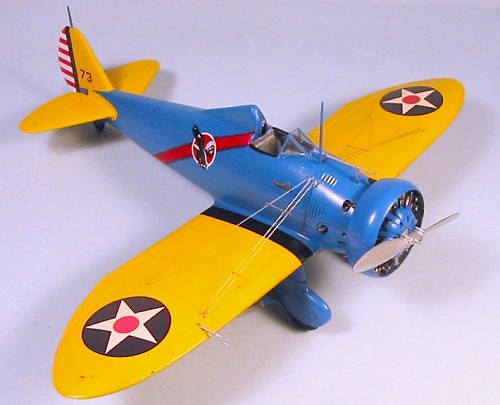 In 1/72 scale,
Revell released a good P-26 model in the late 1960s that can still be
found. Tom’s Modelworks released a 1/48 vacuform in the late 1980s that
made up into a nice model, but the definitive kit in 1/48 - and perhaps the
best kit of the P-26 of all - is the Hobbycraft kit released 12 years ago
in three different versions. This kit is well-detailed, and there are
aftermarket sets by Eduard to make it even better.
In 1/72 scale,
Revell released a good P-26 model in the late 1960s that can still be
found. Tom’s Modelworks released a 1/48 vacuform in the late 1980s that
made up into a nice model, but the definitive kit in 1/48 - and perhaps the
best kit of the P-26 of all - is the Hobbycraft kit released 12 years ago
in three different versions. This kit is well-detailed, and there are
aftermarket sets by Eduard to make it even better.
Hasegawa released their 1/32 P-26A 30 years ago, along with the P-12E, F4B-4 and BF2C-1. These were the best 1/32 kits available at the time, and are still the only kits in this scale of these airplanes ever released. They were accurate and well-detailed, with several markings choices available in the different releases over the following 10 years (other than the BF2C-1, which only ever flew with VB-5B). The kits have been unavailable in commercial release for several years, so it was nice to discover this summer that Hasegawa had done this limited release with markings for P-26s of the 20th Pursuit Group.
The kit is produced with the brittle plastic used by Hasegawa up to the late 1980s, which leads me to wonder if they produced all these kits 30 years ago, put them in storage and released them over the years. The raised surface detail is very petite, and accurate for the P-26, since the panels were lapped on the real thing. The cockpit has adequate detail, but in this scale a modeler can put some effort into superdetailing this area to good effect. The engine is a jewel, making up into a very good-looking Pratt & Whitney Hornet.
Overall, fit is excellent, with the only bad thing being a sink mark in the upper surface of the wingtips, due to the strange production method Hasegawa chose, with an inset lower wing half in this area. I had forgotten that this was endemic to the kit until reminded by a friend. This time, I filled that, sanded it smooth, and replaced the lost surface detail by rescribing the rivets with a pounce wheel. The truth is, this is not a really-apparent sink mark, and it would be virtually invisible under paint, unless viewed under light at the right angle. Were I doing it again I would leave it alone, and that is my advice to you.
| CONSTRUCTION |
The kit is so well-engineered that - other than the mistaken filling of the wingtip sink mark - I only used Mr. Surfacer on the centerline seam of the fuselage and the seams where the two halves of the cowling are glued together.
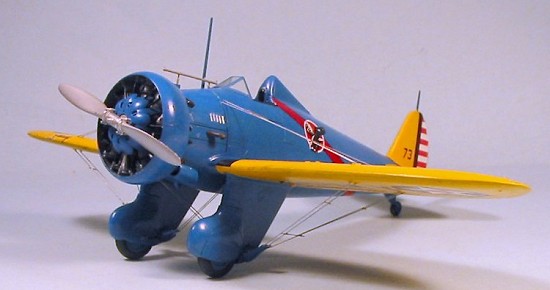 I assembled the
engine and cowling, the fuselage, the wings and the landing gear as
separate sub-assemblies. I left the cockpit as is, other than to add
Cutting Edge posable resin seatbelts - remember that in the 1930s, American
airplanes did not feature shoulder harnesses. Using a”hot” glue, in this
case Ambroid Pro-Weld, the small gaps in the wing and horizontal stabilizer
joints were filled with melted plastic and then lightly rescribed.
I assembled the
engine and cowling, the fuselage, the wings and the landing gear as
separate sub-assemblies. I left the cockpit as is, other than to add
Cutting Edge posable resin seatbelts - remember that in the 1930s, American
airplanes did not feature shoulder harnesses. Using a”hot” glue, in this
case Ambroid Pro-Weld, the small gaps in the wing and horizontal stabilizer
joints were filled with melted plastic and then lightly rescribed.
The kit provides only the very early tail wheel, which was a fitting that led to ground-looping. I scratchbuilt the later tail wheel mount.
The engine was painted and the cowling attached to it before painting. With that done, the kit came together over a weekend and was ready for paint.
| COLORS & MARKINGS |
Painting:
I painted the wings
and tail Army Chrome Yellow (a different color than Navy Chrome Yellow).
this is a more intense yellow than Insignia Yellow, obtained by using
Tamiya Flat Yellow with a bit of Red added in. The fuselage, landing gear
and cowling ring were painted Air Corps Blue, which I mixed with Tamiya
Blue and Sky Blue, both gloss colors. The big effort in painting was
masking off the yellow to paint the fuselage, and I really enjoyed having
the thin Tamiya tape to use for the borders, which I could define by
pushing the tape do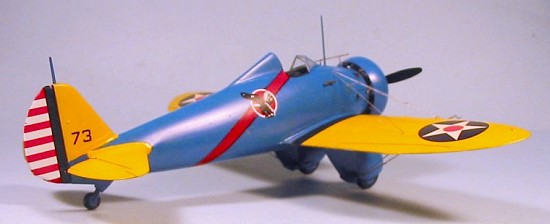 wn
right, then trimming with an X-acto. I also painted the fuselage stripe
Insignia Red. The propeller was painted with Alclad II Polished Aluminum.
wn
right, then trimming with an X-acto. I also painted the fuselage stripe
Insignia Red. The propeller was painted with Alclad II Polished Aluminum.
Decals:
I didn’t particularly like the quality of the Hasegawa decals, so I decided to do a P-26A of the 17th Pursuit Squadron of the 1st Pursuit Group, circa 1935, since I had a 1/32 scale decal for the squadron insignia from a Cutting Edge P-36 sheet. I used the kit decals for the national insignia, “U.S. ARMY” marking and rudder stripes.
Rigging:
Rigging was easy since the kit was produced with holes in the right places to the model could be rigged with thread. I used .010 stainless steel wire for this model.
| FINAL CONSTRUCTION |
I fitted the individual exhausts on the engine and attached the engine to the airframe. These airplanes were maintained in immaculate condition, so I did no weathering.
| CONCLUSIONS |
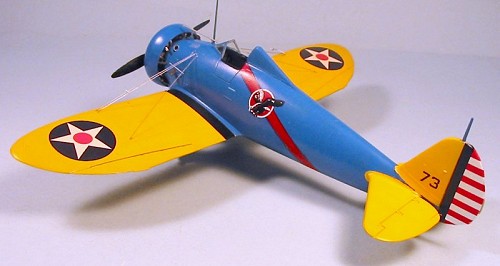 This kit is still
the only game in town for a modeler who wants a P-26 in this scale.
Fortunately, it is a kit that was ahead of its time in production quality
as regards detail and fit, and it has aged “like fine wine.” Personally I
wish I could have gotten an earlier one with the better decal sheet, which
offers more options. Whether built out of the box or given the
super-detailing treatment, this is an excellent model. I hope that
Hasegawa will follow up this re-release with the other 1/32 “Golden Age”
kits in the series.
This kit is still
the only game in town for a modeler who wants a P-26 in this scale.
Fortunately, it is a kit that was ahead of its time in production quality
as regards detail and fit, and it has aged “like fine wine.” Personally I
wish I could have gotten an earlier one with the better decal sheet, which
offers more options. Whether built out of the box or given the
super-detailing treatment, this is an excellent model. I hope that
Hasegawa will follow up this re-release with the other 1/32 “Golden Age”
kits in the series.
September 2005
Review kit courtesy of HobbyLink Japan - get yours at www.hlj.com
If you would like your product reviewed fairly and fairly quickly, please contact the editor or see other details in the Note to Contributors.